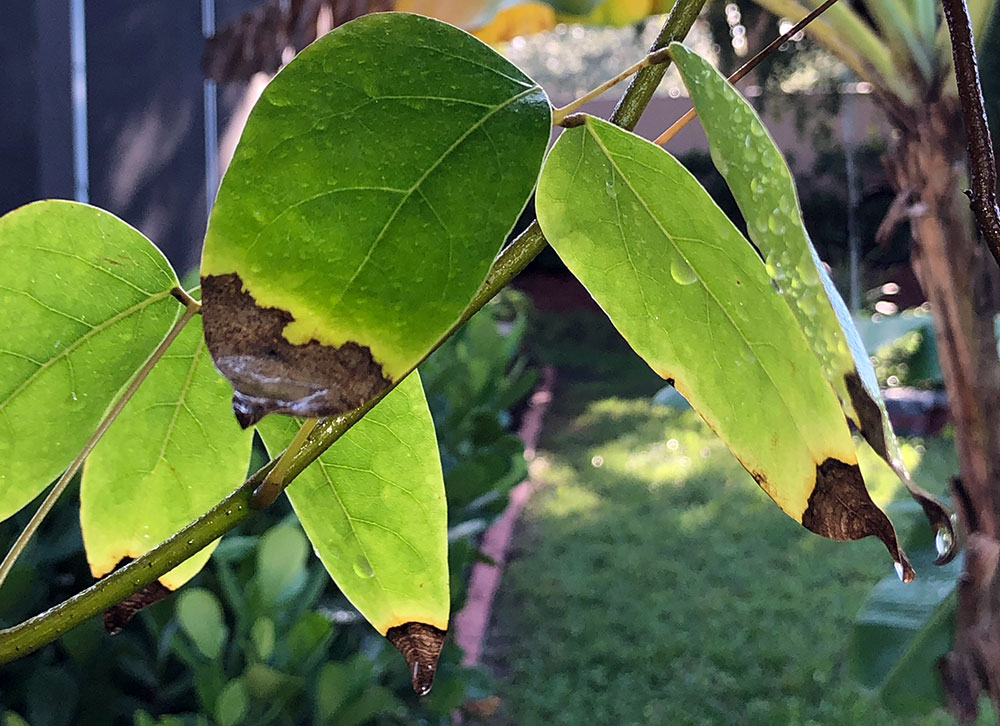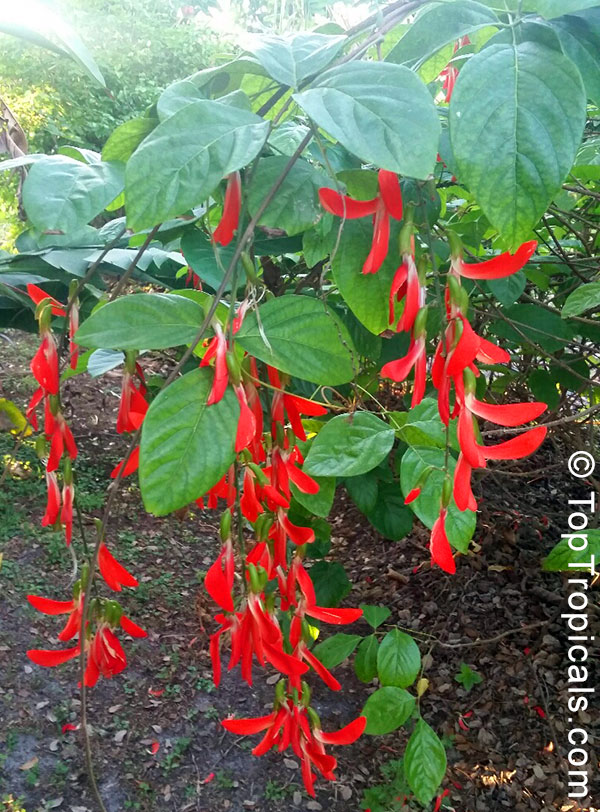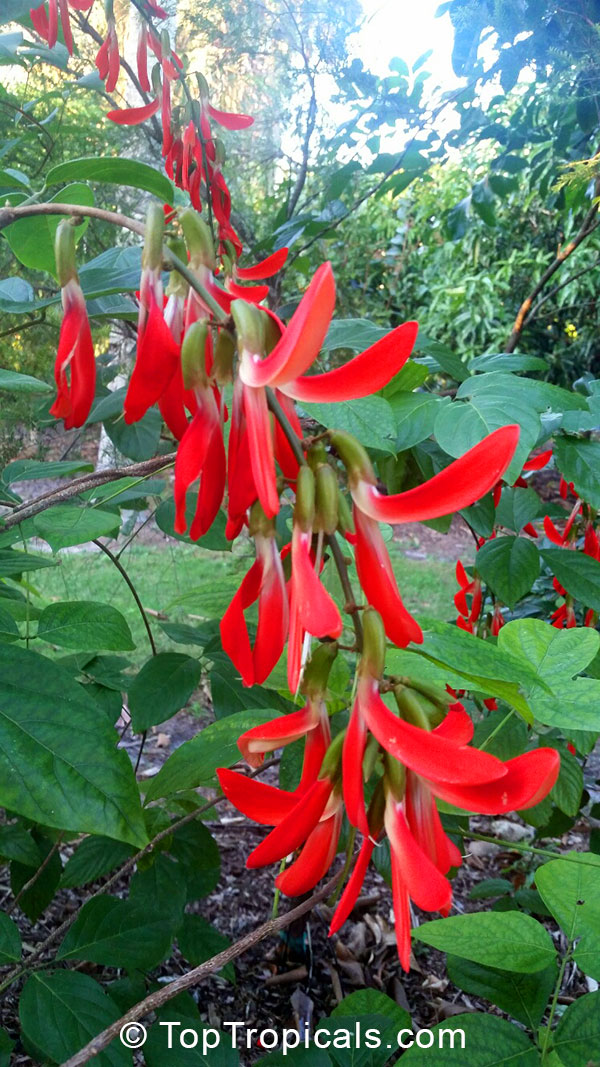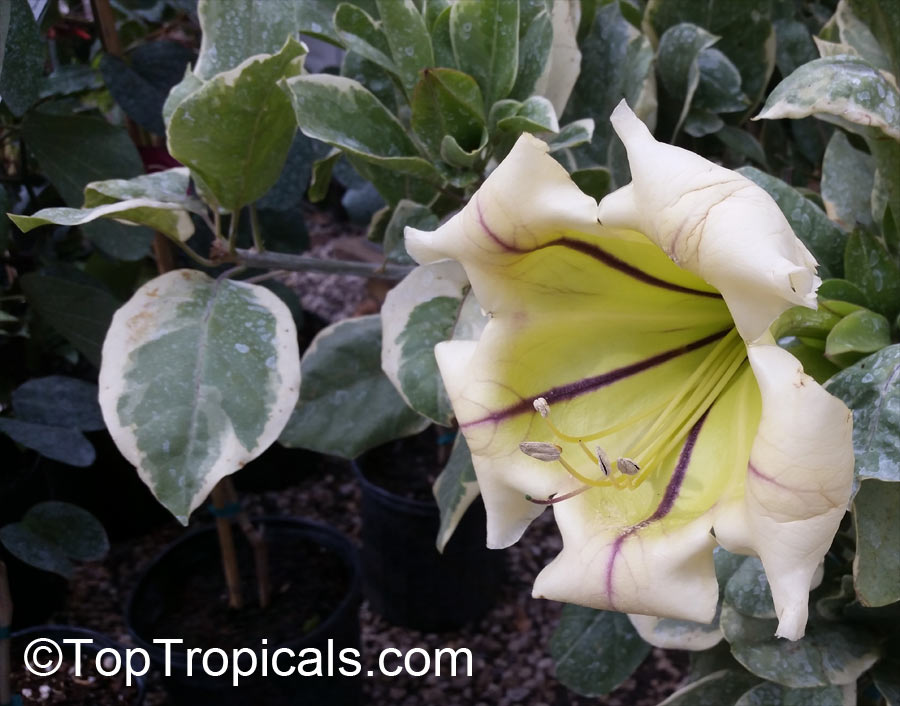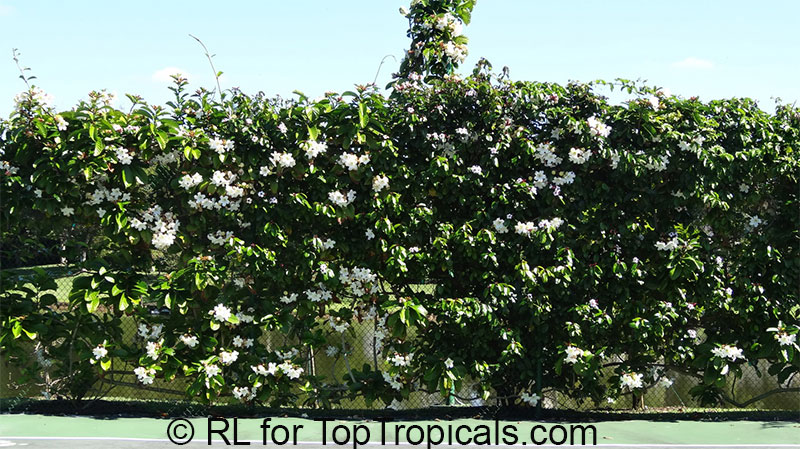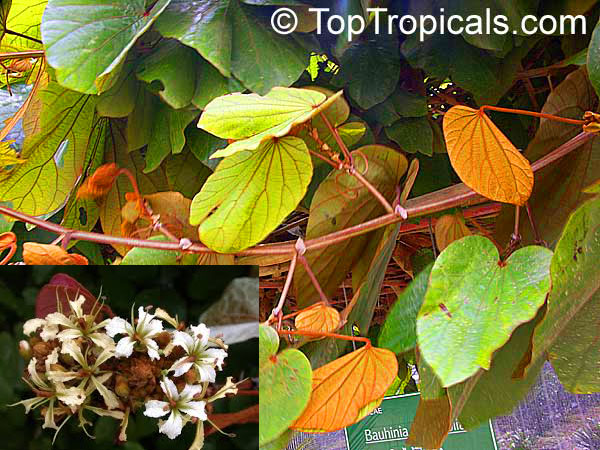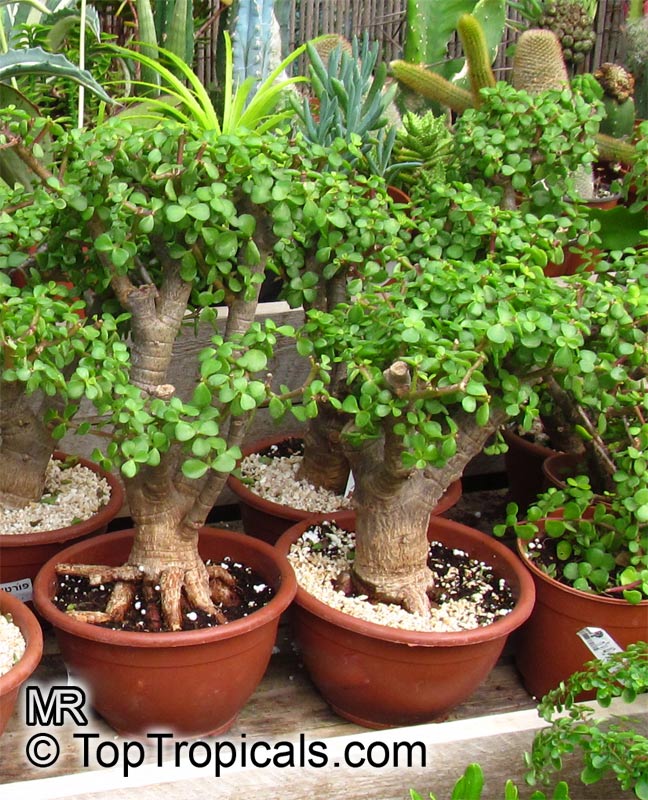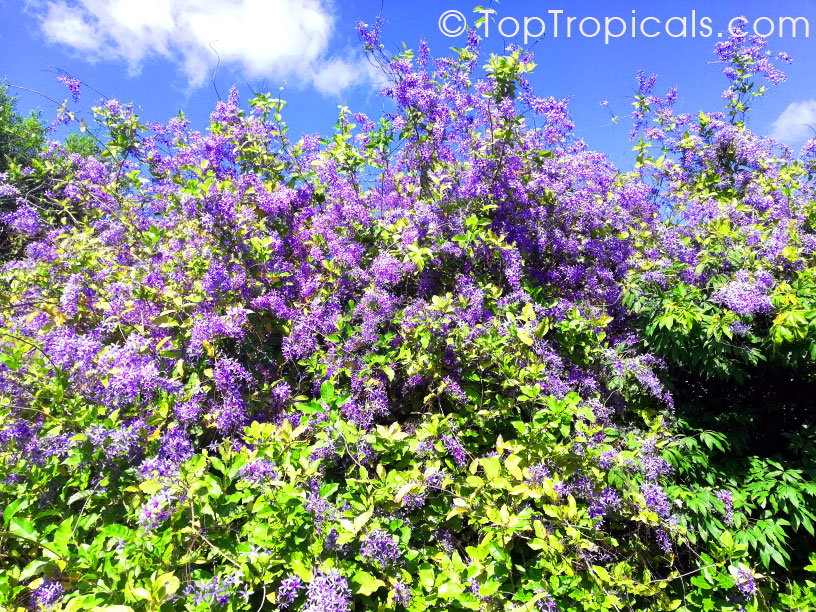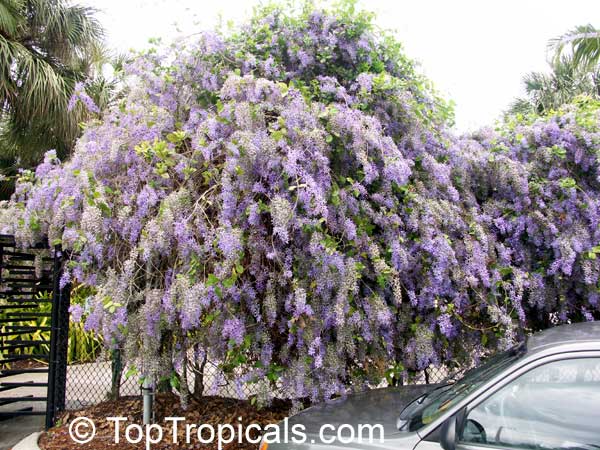Garden Blog - Top Tropicals
Date:
Healthy Plants: Q&A from Mr Booster
How to grow a happy Red Jade Vine?
Q: My Red Jade Vine has the leaf tips turning brown. I water this plant four times a week and I am using a half a teaspoon of miracle grow bloom booster 15-30-15 per 2 gallons, every two weeks. In the beginning I had to water this plant off city water in South Fort Myers. Over the last two months I picked up a dechlorinator buggy plus threw that on my hose and I've been watering it with that but it didn't seem to make a difference. I put this plant in the ground last September. It has three shoots that run into the top of the tree, so it is growing but leaves seem to drop off down low at the base of the vine and the brown tipping running into the top of the plant. But not the newest shoot its leaves are solid green all the way at the top. Thanks for any advice.
A: Mucuna benettii - Red Jade vine - is not the easiest plant to grow, and
we are glad your vine is growing well. For those who love this plant but not
ready to face all challenges, we recommend its cousin - Camptosema grandiflora - Dwarf Red Jade Vine, which is much hardier and
easier plant.
We looked at the photos and these are our thoughts.
1) The top of the plant with green fresh leaves definitely indicates
that the plant is generally healthy and vigorous.
2) Dry tips of the old leaves may indicate excess salts in soil, in
combination with the summer heat that it went through. Based on your feeding program
description, that fertilizer may create a problem. Water soluble traditional
fertilizers are EDTA-chelated which often causes nutrients lock up in soil
and leaf drop. Try to stay away from that fertilizer for a month and let the
rains and/or irrigation water flush the soil for a couple of weeks.
3) Red Jade vine is a very sensitive species. Normally, during hot season
it is safe to use traditional fertilizers, especially slow-release granulated.
However, with this plant we recommend you to switch to more delicate formula
and use only liquid fertilizer.
SUNSHINE Megaflor - Bloom Nutrition Booster will be the best. It is
safe to use it as frequent as with every watering! It is amino-acid
based, and will be totally consumed by the plant without nutrient lockup.
4) Another cause of dry leaf tips may be micro-element deficiency.
Megaflor booster already has all necessary micro-nutrients in it, plus you
may apply some extra: SUNSHINE Superfood.
5) You may continue using regular water for watering (including city water)
as long as you use amino-acid based plant food and supplements: they improve
soil acidity (what tropical plants like is acidic soil, and Florida soils
are alkaline). Additionally, to improve soil acidity which can be critical for
this Mucuna species, you may add 1" layer of pure peat moss on top of the
soil around the plant. Please keep us in loop how the plant is doing. It is
pretty rare species in cultivation and we will be happy to help you to keep it
thriving.
Date:
Hardy Dwarf Red Jade Vine
by Onika Amell, tropical plant specialist
Q: I simply adore Jade vines. I think they are the Queens of all the vines! I have been very been successful growing the green Strongylodon macrobotrys and purple Jade Mucuna pruriens vines here in Clewiston Florida but I am struggling to make the Red Jade vine (Mucuna benettii) thrive. It keeps dying on me during cold snaps. Any suggestions?
A: ...Here is our solution for you. Consider growing a Dwarf Red
Jade Vine or Camptosema grandiflora. It is closely related to the regular and ultra
tropical Red Jade Vine Mucuna benettii but much tougher and hardier. It is
considered to be one of the more cold hardy of the Jade Vines...
This gorgeous, rare and unusual vine is a sheer showstopper. It is easy
to grow and it will reward you with long fiery chains of dangling orange-red
flowers that bloom from late fall to early spring. Even though it is listed
as a dwarf do not be fooled. This vine will get quite large and will need a
strong support over time. The flowers are long and heavy and will show best
when planted on an arbor or pergola where they are able to hang down and wow
you and your visitors. It puts on a wonderful display. Butterflies, bees and
hummingbirds will all thank you for growing this stunner!...
CONTINUE READING >>
Date:
Featured plant.Camptosema grandiflora - Dwarf Red Jade Vine
Camptosema grandiflora - Dwarf Red Jade Vine
Dwarf Red Jade vine. If you always wanted to own THE Red Jade Vine, here is your chance! Also called Cuitelo, Crista-De-Galo (Rooster's Crest), it is sometimes miss-identified as a Mucuna species. This amazing eye-catcher is closely related to Red Jade Vine, however, it is much hardier than the ultra-tropical Mucuna benettii! It is a spectacular fast-growing vine from Brazil with long pendulous chains of fiery bright red flowers. Heavy vine, it needs large trellis or pagoda. An arbor is ideal so that the brilliant flowering racemes can hang down from the ceiling. Blooms in fall and winter. Prune heavily in spring after flowering. Give full or partial sun with adequate moisture and fertilizer. It is very easy to grow, can tolerate some drought and light frost.
Date:
Mucuna nigricans - Black Jade Vine
Black Jade Vine is a real gem of a rare plant collection and a
conversation piece when in bloom. The flower color is beyond description, as most of
the Jade vines. This spectacular woody climber is closely related to red Jade
vine (Mucuna bennettii). Branches sparsely velvet-hairy, and blackish purple
flowers hanging in racemes. Drooping flower-cluster-stalks are up to 1 ft
long and 6" in diameter! The blooms appear closely pushed together in grape-like
clusters. Flowers are clustered in threes; each cluster supported by a
deciduous bract. It is a very vigorous woody tree creeper - during warmer weather
it can grow 2 feet or more a week. Cold hardy in Florida to at least zone 9b.
This plant is a must for every rare tropical plant collection. It is
easy to grow and doesn't require much care once established other than regular
watering. In colder climates with a hard freeze, this spectacular vine can be
grown in a large container providing a strong trellis support.
Date:
Impossibly exotic Chalice Vine
By Onika Amell, our flower specialist
Q: I live on Sanibel Island, Florida and I'm looking for an exotic vine to cover the side of my house. A friend suggested Chalice vine. What can you tell me about it and will it tolerate the salty soil and salt spray of the island?
A: Chalice vine, or Cup of Gold - Solandra maxima - is a large,
woody, scrambling tropical vine with huge, cup-shaped flowers. Variety
Variegata has also amazing cream and green variegated foliage. The flowers are
fragrant, especially in the evenings, with a lovely coconut-like aroma. This
unusual vine will give you intermittent waves of large, wide flaring golden
trumpets.
Even when not in flower, it is beautiful as new growth is bright and
purple-bronze in color. It has a large and loose spreading habit. As this vine
ages, flowers will appear along the entire length of branches off the main
vine. So, just think about it - up to 100 feet vine and you will have about 500
flowers at the same time! They are very fast growing and usually bloom from
February until May. Plant them... Sit back and wait... Four months of heaven!
They are great for seaside gardens as they are very tolerant of salt
spray and salty soils. Will, in fact, thrive in most any well-drained soil.
Give it a large, sturdy pergola or trellis, or train it to grow up the
side of a house where it will spill down over windows and doorways to take
your breath away... Chalice vine is impossibly exotic!
Date:
Vigorous flowering vine for a large trellis
Q: I am looking for a suitable vine for my home. The wall/trellis which I would like to plant the vine(s) is a two-story wall. The area gets lots of light at midday but not direct sunlight. Most of the light comes from the north. Our home is in South Florida (Miami). Would you please suggest a lovely colorful vine(s) that would flower well under these conditions? Maybe one that has fragrance.
A: Below
are some of our suggestions for your project. These flowering vines are
vigorous, fast growing, tolerant of part-sun conditions and still, will produce
flowers for you to enjoy:
Clerodendrum speciosum
Clerodendrum thomsoniae - Bleeding Heart
Jasminum humile - Italian jasmine - fragrant
Jasminum nitidum - Star Jasmine - fragrant
Mansoa alliacea - Garlic Vine
Pyrostegia venusta - Flame Vine
Quisqualis - Rangoon Creeper, Thai Double Flower - fragrant
Thunbergia laurifolia - Blue Sky vine
Urechites lutea - Yellow Mandevilla
Beaumontia murtonii - Nepal Trumpet Flower
- this one has large fragrant flowers and large tropical leaves...
See very interesting story about Beaumontia live fragrant wall.
Check out all vines from our selection and vigorous growers for large areas like fences and big trellises.
Date:
Fragrant Gold Leaf Orchid Vine
By Onika Amell, tropical plant specialist
Q: I am absolutely thrilled to see you have this vine. I've tried for years to get this plant! It is so, so rare. It just seemed impossible to find in this country. How do I make it thrive? I am ordering two.
A: We are happy to confirm that indeed we do have this rare vine!
Bauhinia aureifolia - Gold Leaf Orchid Vine - was discovered in Thailand in
1983. It is endemic to Pattani, Narathiwat, and Yala in Southern Thailand.
Danish botanist Kai Larsen named this plant and hailed it as one of the rarest
plant species of the world when it was discovered in the eighties.
The Thai people call this vine Bai Mai Si Thong. It is a beautiful
climber with large, bi-loped leaves (7 inches or more!) and good branching.
Young leaves are a stunning burnt orange to terracotta color for about
a week and as they reach full size, they turn green over a couple of days.
This is a very rare color for Bauhinia. It produces leaves all the time and
this means this vine is always full of beautiful color. With its golden leaves,
it sure is reminiscent of Autumn.
This vine blooms from May to November. It bears bunches of small
flowers that are delicately fragrant in the evenings. The cultivated plants range
flower color from pure white to purple and pink, while the wild ones have
often white petals with pinkish patches.
Bauhinia aureifolia needs well-drained soil, full light and good humidity
to thrive. It will tolerate a light freeze once established and it is very
important to protect young plants.
Gold Leaf Orchid Vine also makes a wonderful container plant with staking
or support. It is a must for every rare plant collection!
RECOMMENDED FERTILIZERS:
Pink N Good Daily Plant Food - Flower Booster
Tropical Allure - Smart-Release Booster
Date:
Fascinating Spekboom (Portulacaria afra, or Baby Jade)

By Mark Hooten, the Garden Doc
...I love this plant! I first grew it in the 1960s when I was just a
kid. I found it growing as a fantastic four-foot tall houseplant in a big sunny
window in a schoolmate's home and was happily given a cutting. When I
inquired about this most unusual plant, my friend's mother explained that she had
brought a piece of it with her when she came from South Africa many years
earlier. She told me that in Africa, it is a favorite food for both Elephants and
Rhinoceros and that it was grown all over her families farm for feeding both
animals and people. Being a little kid in Illinois, I found this especially
fascinating...
Continue reading...
Date:
Breathtaking Queen's Wreath
By Onika Amell, tropical flower specialist
Q: I've just moved from Virginia to Sarasota, Florida. I'm looking for a vine similar to Wisteria to grow in my new garden. I've so enjoyed my Wisteria vine and I'm hoping to find something equally spectacular for my FL garden. Truth is, I'm getting older and won't be able to keep up with the hard-core maintenance Wisteria needs to keep it in under control. Is there a similar vine you can recommend that is just as showstopping as Wisteria?
A: The vine that immediately comes to mind is Petrea Volubilis or Queens wreath. It looks similar to Wisteria, and though a fast and strong climber, it's not invasive or
destructive at all. An occasional pruning is all it will need to maintain it.
Much like Wisteria it gives a glorious show of flowers when spring arrives.
Masses of long, mauve flowers will continue to appear on and off in summer with
another burst of flowers in the fall. Flowers are up to a foot in length!
Hummingbirds, bees, and butterflies will all be impressed with you for
growing this charmer.
Snip off the gorgeous flowers, put them in shallow bowls of water
around your home and be the envy of all your friends and house guests!
This vine prefers the warmth of Zone 10 to thrive, but it will survive
in areas of Zone 9B when it borders zone 10A, especially if it's placed in a
protected area. It grows best in full sun but will tolerate part shade. It's
great for coastal gardens and once established, it has good drought
tolerance, medium salt tolerance, and good wind tolerance. It has no major pest
problems, which is always a bonus.
Grow and shape it as you like: a large bush, a small tree or a
breathtaking espalier. Some people plant Petrea vine by a tree to create that much
sought-after ethereal wisteria effect. This is no doubt a very charming vine
and a must-have for those who are in love with Wisteria but scared of its
vigorous growth and ongoing maintenance.
For Wisteria lovers we also recommend its spectacular tropical relative
Millettia reticulata - Evergreen Wisteria.
Date:
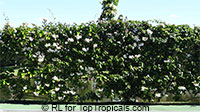
Easter Lily Vine creates a fragrant privacy fence of virtually unlimited size
By Ron, South Florida. Easter Lily Vine (Beaumontia grandiflora) is a magnificent woody evergreen climber of unlimited growth potential. A branch of this vine will grow simply until you cut it. I have branches of up to 30 ft. and longer.
I've used two plants to turn a chain-link fence into a privacy screen that is 40 ft. wide by 10 ft. tall, but even a single plant can cover a much wider space if trained properly.
Easter Lily Vine's growth rate is moderate, so it doesn't require constant pruning to keep under control like other vigorous vines. I bought mine in 7 gallon pots, and planted them in the ground immediately. It took about 2 years to completely cover the fence. Since then, I prune it 3-4 times a year.
Keep in mind that these plants are heavy and require a solid structure as support. They twine by nature, but only around items with 3†diameter or more. Mine twined around a near-by lighting pole!
The absolute key in training Easter Lily Vine is to force it to grow horizontally. I recommend planting a young 3 gallon size vine in the ground diagonally, so it grows horizontally. Tie it no more than a foot above ground and let it grow a single branch until the end of the space you want to cover. Then force it to make a U-turn and let it grow the other way. See the following diagram for illustration..
.See step-by-step full size pictures and the rest of the article...


